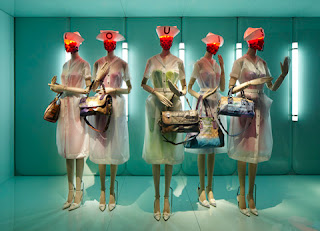Wednesday, March 21, 2012
Louis Vuitton & Marc Jacobs on Exhibit in Paris
It might be a stretch to compare a 21st century American designer to a 19thcentury French trunk maker, but that’s the ambitious conceit of the new “Louis Vuitton – Marc Jacobs” exhibit that just opened at Paris’s Musée des Arts Décoratifs and runs through September 16th. Visitors who climb the stairs to the first floor of the multi-media exhibit are immediately confronted with formal portraits of the two men: Louis Vuitton drawn in 1892 by Studio Reutlinger and Marc Jacobs peering out of a highly stylized Rankin photograph. The show, dreamed up by curator Pamela Golbin, compares the work of these two innovators in the context of the seismic cultural and industrial shifts of their times. In broad strokes, it’s an analysis of the fashion industry during two decisive periods of enormous change—19th century industrialization and 21st century globalization. That’s really where the similarities between Mr. Vuitton and Mr. Jacobs end. After all, what do 19th century steamer trunks have in common with $3,000 Murakami bags?
You would be surprised.
The first floor of the exhibit is in many ways the more interesting one. As a student of history, I was thrilled to learn more about what made Louis Vuitton’s trunks so special. By defining what a “packer” was and the importance of this trade in 1850s Paris, Golbin traces the birth of luxury back to this period and demonstrates the critical role innovation has always played in the business, even back when Vuitton was stamping “English spoken” on his trunks and devising ways to waterproof them.
In many ways Vuitton, like Jacobs, was a trendsetter. Through vitrines filled with elaborate displays of doll clothing representing the wardrobe necessities of mid-19th century women, Golbin shows how entrepreneurial Vuitton was when he began making trunks for haute couture clients who had to change up to six times a day, necessitating over twenty trunks for travel. Although he called himself a “packager,” Vuitton understood the power of celebrity and branding. His shop was across the Place Vendome from the ateliers of Charles Frederick Worth, the world’s first couturier. And long before Marc Jacobs called up Takashi Murakami, Vuitton was co-branding, often printing Worth’s name on a plaque on his trunks. Vuitton paved the way for many other luxury practices, too. Over a century before Jacobs met Sofia Coppola; Vuitton became Empress Eugenie’s personal packer. He also fended off copiers by changing the patterns on his trunks from stripes to squares (incidentally it wasn’t Vuitton, but his son Georges who came up with the now-famous monogram in 1896, after his father’s death).
Jacobs and Vuitton had other commonalities: They both discovered Paris as young men, and they were obsessed with industrial changes happening in the world around them. For Vuitton that meant travel, steam engines, and haute couture. For Jacobs it meant the globalization of communication through the internet.
The second floor of the exhibit is devoted to Jacobs’ work for Vuitton and is presented by the exhibit’s brilliant designers, Sam Gainsbury and Joseph Bennett, as a kind of giant Tumblr page. Walls covered in video images and still photos present a kind of mood board of Jacobs’ disparate sources of inspiration—from Elizabeth Taylor to Mick Jagger to South Park characters and stills from The Wizard of Oz. There are endless images of women, too, from Barbra Streisand to Madonna, Diana Vreeland, Rei Kawakubo, and Liza Minelli. Jacobs’ voice can be heard in some of the rooms, discussing ideas about design and collaborations with artists like Murakami and Richard Prince. Seemingly random displays of Jacobs’ ready-to-wear designs are less compelling than the artist collaborations, including a giant “chocolate box” of Vuitton handbag designs and a vitrine containing Richard Prince’s silk screened bags held aloft by mannequins wearing the nurse’s outfits Jacobs designed for the runway finale in 2008.
These artist collaborations have been, without a doubt, the most successful part of Jacobs’ work at Vuitton. And in that sense, perhaps the most telling part of the whole exhibit is the display case containing Marcel Duchamp’s famous 1930 reproduction of the Mona Lisa with a moustache, entitled L.H.O.O.Q., on loan from the Pompidou Center. This inclusion may seem random to the casual observer, but it represents Jacobs’ greatest contribution to Vuitton’s legacy: irreverence.
As Jacobs explains on the speaker system, “I’m in a position of being respectful and disrespectful. I want to do something rebellious, and also to celebrate this icon.” And with that simple gesture of rebellion—whether it’s an LV logo redrawn by Murakami or a Speedy bag defaced by Stephen Sprouse—Jacobs has brought Vuitton’s 19th century brand into the 21st century.
via NMdaily
Subscribe to:
Post Comments (Atom)


















No comments:
Post a Comment